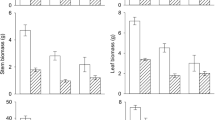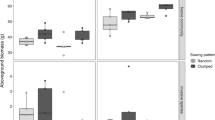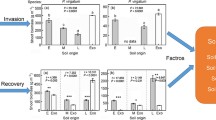Abstract
Successful plant invasions depend, at least partly, on interactions between introduced plants and native plant communities. While allelopathic effects of introduced invaders on native resident species have received much attention, the reverse, i.e. allelopathic effects of native residents on introduced plants, have been largely neglected. Therefore, we tested whether allelopathy of native plant communities decreases their invasibility to introduced plant species. In addition, we tested among the introduced species whether the invasive ones are more tolerant to allelopathy of native plant communities than the non-invasive ones. To test these hypotheses, we grew nine pairs of related (congeneric or confamilial) invasive and non-invasive introduced plant species (i.e. 18 species) in the presence or absence of a native grassland community, which consisted of three common forbs and three common grasses, with or without activated carbon in the soil. Activated carbon reduced the survival percentage and growth of introduced plants in the absence of the native plant community. However, its net effect on the introduced plants was neutral or even slightly positive in the presence of the native community. This might suggest that the native plant community imposed allelopathic effects on the introduced plants, and that these effects were neutralized or reduced by activated carbon. The invasive and non-invasive introduced plants, however, did not differ in their tolerance to such allelopathic effects of the native plant community. Thus, although allelopathy of native plant communities might increase their resistance against introduced plants, there was no evidence that tolerance to allelopathy of native plant communities contributes to the degree of invasiveness of introduced plants.


Similar content being viewed by others
References
Abhilasha D, Quintana N, Vivanco J, Joshi J (2008) Do allelopathic compounds in invasive Solidago canadensis s.l. restrain the native European flora? J Ecol 96:993–1001
Aschehoug E, Callaway R, Newcombe G, Tharayil N, Chen S (2014) Fungal endophyte increases the allelopathic effects of an invasive forb. Oecologia 175:285–291
Bais HP, Weir TL, Perry LG, Gilroy S, Vivanco JM (2006) The role of root exudates in rhizosphere interactions with plants and other organisms. Annu Rev Plant Biol 57:233–266
Bates D, Maechler M, Bolker B Walker S (2014) lme4: linear mixed-effects models using Eigen and S4. R package version 1.1-7. http://CRAN.Rproject.org/package=lme4
Bauer J, Shannon S, Stoops R, Reynolds H (2012) Context dependency of the allelopathic effects of Lonicera maackii on seed germination. Plant Ecol 213:1907–1916
Blossey B, Nötzold R (1995) Evolution of increased competitive ability in invasive nonindigenous plants: a hypothesis. J Ecol 83:887–889
Brown BJ, Mitchell RJ, Graham SA (2002) Competition for pollination between an invasive species (purple loosestrife) and a native congener. Ecology 83:2328–2336
Callaway RM, Ascheoug ET (2000) Invasive plants versus their new and old neighbours: a mechanism for exotic invasion. Science 290:521–523
Callaway RM, Ridenour WM (2004) Novel weapons: invasive success and the evolution of increased competitive ability. Front Ecol Environ 2:436–443
Callaway RM, Vivanco JM (2007) Invasion of plants into native communities using the underground information superhighway. Allelopathy J 19:143–151
Chytrý MP, Pyšek J, Wild J, Pino L, Maskell C, Vilà M (2009) European map of alien plant invasions based on the quantitative assessment across habitats. Divers Distrib 15:98–107
Cummings J, Parker I, Gilbert G (2012) Allelopathy: a tool for weed management in forest restoration. Plant Ecol 213:1975–1989
Del Fabbro C, Prati D (2015) The relative importance of immediate allelopathy and allelopathic legacy in invasive plant species. Basic Appl Ecol 16:28–35
Del Fabbro C, Güsewell S, Prati D (2014) Allelopathic effects of three plant invaders on germination of native species: a field study. Biol Invasion 16:1035–1042
Egli P, Schmid B (2001) The analysis of complex leaf survival data. Basic Appl Ecol 2:223–231
Ens EJ, Bremner JB, French K, Korth J (2009) Identification of volatile compounds released by roots of an invasive plant, bitou bush (Chrysanthemoides monilifera spp. rotundata), and their inhibition of native seedling growth. Biol Invasion 11:275–287
Felsenstein J (1985) Phylogenies and the comparative method. Am Nat 125:1–15
Gruntman M, Pehl A, Joshi S, Tielbörger K (2014) Competitive dominance of the invasive plant Impatiens glandulifera: using competitive effect and response with a vigorous neighbour. Biol Invasion 16:141–151
He WM, Feng Y, Ridenour W, Thelen G, Pollock J, Diaconu A, Callaway R (2009) Novel weapons and invasion: biogeographic differences in the competitive effects of Centaurea maculosa and its root exudate (±)-catechin. Oecologia 159:803–815
Hierro JL, Callaway RM (2003) Allelopathy and exotic plant invasion. Plant Soil 256:29–39
Hou Y, Peng S, Ni G, Chen L (2012) Inhibition of invasive species Mikania micrantha H.B.K. by native dominant trees in China. Allelopathy J 29:307–314
Inderjit, Callaway RM (2003) Experimental designs for the study of allelopathy. Plant Soil 256:1–11
Inderjit, del Moral R (1997) Is separating resource competition from allelopathy realistic? Bot Rev 63:221–230
Inderjit, Duke S (2003) Ecophysiological aspects of allelopathy. Planta 217:529–539
Inderjit, Wardle DA, Karban R, Callaway RM (2011) The ecosystem and evolutionary contexts of allelopathy. Trends Ecol Evol 26:655–662
Jarchow ME, Cook BJ (2009) Allelopathy as a mechanism for the invasion of Typha angustifolia. Plant Ecol 204:113–124
Kabouw P, Nab M, van Dam NM (2010) Activated carbon addition affects substrate pH and germination of six plant species. Soil Biol Biochem 42:1165–1167
Kempel A, Chrobock T, Fischer M, Rohr RP, van Kleunen M (2013a) Determinants of plant establishment success in a multispecies introduction experiment with native and alien species. Proc Natl Acad Sci 110:12727–12732
Kempel A, Nater P, Fischer M, van Kleunen M (2013b) Plant-microbe-herbivore interactions in invasive and non-invasive alien plant species. Funct Ecol 27:498–508
Keser LH, Visser EJW, Dawson W, Song Y-B, Yu F-H, Fischer M, Dong M, van Kleunen M (2015) Herbaceous plant species invading natural areas tend to have stronger adaptive root foraging than other naturalized species. Front Plant Sci 6:273
Klironomos JN (2002) Feedback with soil biota contributes to plant rarity and invasiveness in communities. Nature 417:67–70
Kueffer C, Pyšek P, Richardson DM (2013) Integrative invasion science: model organisms, multi-site studies, unbiased meta-analysis, and invasion syndromes. New Phytol 200:615–633
Kulmatiski A (2011) Changing soils to manage plant communities: activated carbon as a restoration tool in ex-arable fields. Restor Ecol 19:102–110
Lankau RA (2013) Species invasion alters local adaptation to soil communities in a native plant. Ecology 94:32–41
Lau JA, Puliafico KP, Kopshever JA, Steltzer H, Jarvis EP, Schwarzländer M, Strauss SY, Hufbauer RA (2008) Inference of allelopathy is complicated by effects of activated carbon on plant growth. New Phytol 178:412–423
Mahall BE, Callaway RM (1992) Root communication mechanisms and intracommunity distributions of two Mojave Desert shrubs. Ecology 73:2145–2151
Murrell C, Gerber E, Krebs C, Parepa M, Schaffner U, Bossdorf O (2011) Invasive knotweed affects native plants through allelopathy. Am J Bot 98:38–43
Nolan N, Kulmatiski A, Beard KH, Norton J (2015) Activated carbon decreases invasive plant growth by meditating plant-microbe interactions. AoB Plants 7:plu072. doi:10.1093/aobpla/plu072
Orr SP, Rudgers JA, Clay K (2005) Invasive plants can inhibit native tree seedlings: testing potential allelopathic mechanisms. Plant Ecol 181:153–165
Pearse IS, Harris DJ, Karban R, Sih A (2013) Predicting novel herbivore–plant interactions. Oikos 122:1554–1564
Pinheiro J, Bates D, DebRoy S, Sarkar D, R Core Team (2015) nlme: linear and nonlinear mixed effects models. R package version 3.1-119. http://CRAN.R-project.org/package=nlme
Prati D, Bossdorf O (2004) Allelopathic inhibition of germination by Alliaria petiolata (Brassicaceae). Am J Bot 91:285–288
Qin RM, Zheng YL, Valiente-Banuet A, Callaway RM, Barclay GF, Pereyra CS, Feng YL (2013) The evolution of increased competitive ability, innate competitive advantages, and novel biochemical weapons act in concert for a tropical invader. New Phytol 197:979–988
R Development Core Team (2011) R: a language and environment for statistical computing. R foundation for statistical computing, Vienna. ISBN 3-900051-07-0. http://www.R-project.org/
Rabotnov TA (1982) Importance of the evolutionary approach to the study of allelopathy. Ékologia 3:5–8 (Translated from)
Reichard SH, White P (2001) Horticulture as a pathway of invasive plant introductions in the United States: most invasive plants have been introduced for horticultural use by nurseries, botanical gardens, and individuals. Bioscience 51:103–113
Rice EL (1974) Allelopathy. Academic, New York
Richardson DM, Pysek P (2006) Plant invasions: merging the concepts of species invasiveness and community invasibility. Prog Phys Geog 30:409–431
Ridenour WM, Callaway RM (2001) The relative importance of allelopathy in interference: the effects of an invasive weed on a native bunchgrass. Oecologia 126:444–450
Saul W, Jeschke J, Heger T (2013) The role of eco-evolutionary experience in invasion success. NeoBiota 17:57–74
Schlaepfer DR, Glättli M, Fischer M, van Kleunen M (2010) A multi-species experiment in their native range indicates pre-adaptation of invasive alien plant species. New Phytol 185:1087–1099
Singh HP, Batish DR, Kohli RK (2003) Allelopathic interactions and allelochemicals: new possibilities for sustainable weed management. Crit Rev Plant Sci 22:239–311
Stinson KA, Campbell SA, Powell JR, Wolfe BE, Callaway RM, Thelen GC, Hallett SG, Prati D, Klironomos JN (2006) Invasive plant suppresses the growth of native tree seedlings by disrupting belowground mutualisms. PLoS Biol 4:e140
Svensson JR, Nylund GM, Cervin G, Toth GB, Pavia H (2013) Novel chemical weapon of an exotic macroalga inhibits recruitment of native competitors in the invaded range. J Ecol 101:140–148
van Kleunen M, Dawson W, Bossdorf O, Fischer M (2014) The more the merrier: multi-species experiments in ecology. Basic Appl Ecol 15:1–9
van Kleunen M, Dawson W, Maurel N (2015) Characteristics of successful alien plants. Mol Ecol 24:1954–1968
Verhoeven KJF, Biere A, Harvey JA, Der PuttenWH Van (2009) Plant invaders and their novel natural enemies: who is naive? Ecol Lett 12:107–117
Weißhuhn K, Prati D (2009) Activated carbon may have undesired side effects for testing allelopathy in invasive plants. Basic Appl Ecol 10:500–507
Wills RJ (1985) The historical bases of the condept of alleopathy. J Hist Biol 18:71–102
Wurst S, Van Beersum S (2009) The impact of soil organism composition and activated carbon on grass–legume competition. Plant Soil 314:1–9
Wurst S, Vender V, Rillig M (2010) Testing for allelopathic effects in plant competition: does activated carbon disrupt plant symbioses? Plant Ecol 211:19–26
Young GP, Bush JK (2009) Assessment of the allelopathic potential of Juniperus ashei on germination and growth of Bouteloua curtipendula. J Chem Ecol 35:74–80
Zuur A, Ieno EN, Walker N, Saveliev AA, Smith GM (2009) Mixed effects models and extensions in ecology with R. Springer, New York
Acknowledgments
We thank Otmar Ficht, Claudia Martin and Timo Scheu for assistance with the experiment, Wayne Dawson, Yanjie Liu, Mialy Razanajatovo, Ayub Oduor and Noëlie Maureland for helpful comments on earlier manuscript drafts, and the Fundamental Research Funds for the Central Universities (2015ZCQ-BH-01), NSFC (31570413) and the China Scholarship Council for financial support.
Author information
Authors and Affiliations
Corresponding author
Appendices
Appendix 1
See Table 3.
Appendix 2
See Table 4.
Appendix 3
See Fig. 3.
Aboveground biomass (mean ± standard error) of each of the nine invasive and the nine non-invasive introduced species in the presence or absence of the native community with or without activated carbon. See “Appendix 1” section for full species names, and the scales of y axes differ among species
Appendix 4
See Fig. 4.
Rights and permissions
About this article
Cite this article
Ning, L., Yu, FH. & van Kleunen, M. Allelopathy of a native grassland community as a potential mechanism of resistance against invasion by introduced plants. Biol Invasions 18, 3481–3493 (2016). https://doi.org/10.1007/s10530-016-1239-6
Received:
Accepted:
Published:
Issue Date:
DOI: https://doi.org/10.1007/s10530-016-1239-6






